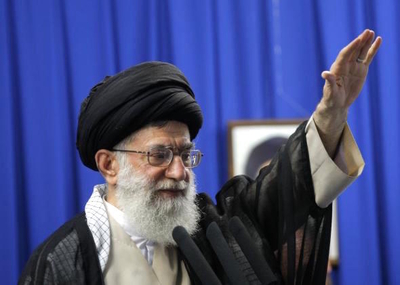Iran’s Next Supreme Leader and the Nuclear Deal
Mehdi Khalaji/Politico
March 11, 2015
In all likelihood, Khamenei’s potentially imminent successor will be even more of a hardliner, and he could renege on a deal just as easily as the next U.S. president.
In their controversial letter to “the leaders of the Islamic Republic of Iran,” U.S. Sen. Tom Cotton and 46 other Republican senators suggested that even if Washington comes to a nuclear deal with President Obama, the next American president could decide to reject it, presumably if he (or she) were more of a hard-liner than Obama is.
But the next ayatollah who becomes supreme leader of Iran could do exactly the same thing — and many signs indicate that he is going to be more of a hard-liner. Ironically, opponents of a nuclear deal in Washington could well be contributing to this outcome by creating an atmosphere of mistrust in Tehran that only consolidates the power of the conservatives there.
Moreover, whoever the next supreme leader of Iran is, there’s every chance we could be meeting him sooner rather than later. In recent weeks fresh reports have surfaced about the deteriorating health of the current occupant of that office, Ayatollah Ali Khamenei, raising questions about Iran’s future at a critical moment in the nuclear negotiations with the West. True, it is difficult, if not impossible, to separate fact from rumor. Even though Tehran, in an unprecedented decision, recently publicized Khamenei’s “prostate removal operations,” the government considers the facts of his illness to be a matter of national security; both the Shah and Khamenei’s predecessor, Ayatollah Ruhollah Khomeini, were extremely ill during their rule, yet knowledge of their true health was limited to a handful of people and family members. And some Iranian politicians have a vested interest in spreading stories about — or at least exaggerating — Khamenei’s declining health for their own political purposes as they look to sway the views of the Assembly of Experts, the council of more than 80 members that is charged by the constitution with the succession issue.
Nevertheless, when it does come, Khamenei’s death will transform the Islamic Republic as fundamentally as the death of Ayatollah Khomeini and the ascendance of Khamenei himself did in 1989. And if current indications are any guide, when that happens Iran could become even tougher to deal with than it already is. Even the current standoff over Iran’s nuclear program could affect the final decision about succession, since the outspokenness of hardliners in the U.S. Senate, and Cotton’s reportedly unprecedented action, will likely only stiffen the views of the hardliners in Tehran.
In any case, the next supreme leader will be able to determine to what extent any possible nuclear deal is sustainable in the long term. Even more than the U.S. Senate, the next supreme leader would be in a position to renege on any pact with the West and easily justify it politically or technically. According to the official philosophy of the Islamic Republic elaborated by its founding father, Ayatollah Khomeini, the supreme leader is religiously authorized to unilaterally terminate any government contract or agreement, even with Iranian citizens, if he sees it necessary for “expediency of the regime” — which trumps both constitution and Islamic law (Sharia). Officially, the only legal source for recognizing the “expediency of the regime” is the ruling ayatollah.
Granted, there is much we don’t know about the plans for succession in Iran. First of all, such a choice has been made only once in the entire 36-year history of the Islamic Republic. If we were to assume that the Assembly of Experts, whose members are all ayatollahs and represent each province, had the ultimate power to appoint the new leader, given its current makeup it would certainly choose a hardliner who might be even be more aggressive on foreign and domestic policy than Khamenei himself. The assembly’s preference for hardliners was evident in its March 10 election for chairman, in which Ayatollah Mohammad Yazdi beat Akbar Hashemi Rafsanjani, securing 47 votes against Rafsanjani’s 26. Rafsanjani, who is known in the West as a pragmatist and for supporting a free-market economy, has lost his power base within the political structure of the Islamic Republic since the end of his presidency. He has lost two major elections, parliamentary and presidential in 2000 and 2005, but in recent years he became popular among supporters of defeated presidential candidates in 2009, because of his long history of animosity with Ahmadinejad and his open criticism of the government’s suppressive policy toward the Green Movement.
However, such popularity does not necessarily translate into political power. Former President Mohammad Khatami is one of the most popular politicians in Iran, but the government launched a fierce campaign to marginalize him and neutralize his power. Official Iranian media was banned from mentioning his name or showing his picture, and he is forbidden from leaving the country. This is true more generally for the majority of the Iranian population who support moderation and openness to the world, yet are deprived from political organizations, civil institutions and leadership. The hardcore conservatives who make up the Islamic Republic and its cadres, on the other hand, have access to a powerful religious network, governmental organizations, and social institutions, and by using all these tools and mechanisms they are able to mobilize the minority and secure an acceptable participation rate in both elections and ritual demonstrations and portray it as a clear sign of the regime’s legitimacy. In other words, this majority does not pose a serious threat to the minority that monopolizes the media, and holds prison keys in one hand and a gun in the other.
But in truth the Assembly of Experts has never been significant in the power structure, with the exception of its first term during which it was in charge of writing the Iranian constitution. In the last 26 years under Khamenei, the assembly has been relegated to a predominantly ceremonial role with no real leverage to supervise or monitor the leader, let alone hold him accountable. This is reflected in voter turnout for the assembly, which compared to country, municipal, presidential, and parliamentary elections, has consistently had the lowest participation. Common wisdom in Iran is that the assembly simply provides legitimacy to the institution of the Guardianship of the Jurisprudent (velayat-e faqih), but is not taken seriously by either the supreme leader or major political institutions and elite circles.
Only since the death of Mohammad Reza Mahdavi Kani, the former head of the assembly, a few months ago and the government’s decision to publicize Khamenei’s operation have people begun to focus their attention on the assembly. Despite the multiple factors and actors who will unquestionably influence decisions concerning succession, ultimately the Assembly of Experts is the sole body that can legitimize and legalize it. Elections for both the Assembly of Experts and parliament are slated for February 26, 2016, and while MPs are elected for a four-year term, Assembly of Experts member are elected for a seven-year term. This means that the next assembly — if not the current one — will likely decide who Khamenei’s successor will be.
In 1989, Khamenei came to power as a weak leader, and many expected him to submit to the will of the president’s executive power and serve primarily as a nonpartisan spiritual leader who would lend Islamic legitimacy to the regime. But this was not to be. Khamenei cleverly invested in his relations with the military, especially the notorious Islamic Revolutionary Guard Corps, the country’s intelligence apparatus, the judiciary, and the media. This helped him create a real power base that enabled him to micromanage these institutions and extend his power beyond the constitutional mandates. Over the past 26 years, he has slowly consolidated control over both the president and the parliament, and he now has the final say on matters of military doctrine and foreign and nuclear policy. On the religious front, he has revolutionized the Shiite clerical establishment and religious network by modernizing its traditional structure into a highly bureaucratized and digitalized system that serves only the regime. He has similarly transformed the office of the supreme leader from a traditional and simple bureaucracy with limited staff, all of whom were clerics, into a large and sophisticated office with more than 4,000 employees — many of whom, including clerics, have a background in military and intelligence.
The process of appointing the supreme leader has always been much more complicated than it appears. But the current climate presents far more challenges than 26 years ago. At the time of Khamenei’s election, the IRGC, the intelligence apparatus and the judiciary were not monopolized by the hardliners, nor did they have much sway in the country’s economic and political dimensions, as they do today. But with an increasing number of actors involved in questions of leadership and succession, there has also been a proliferation of disagreements among different hardliner factions, and sometimes they have diverging political and economic interests. These hardliners will have to reach a consensus about Khamenei’s successor; otherwise there will be an unmanageable crisis. Without such consensus or something close to it, moderates in Iran might find an opportunity to exploit these fissures and find a way into the inner circle of power. However, the most likely scenario is one in which competition does not extend beyond the hardliners, and thus the next supreme leader would be the outcome of their agreements.
Whoever succeeds Khamenei as Iran’s next supreme leader also will likely have far less independence. Over the last 26 years Iranian hardliners have successfully insulated the system against both internally and externally driven reforms. The next leader will represent the interests of the hardliners who now wield tremendous political power and can undermine his decisions. If and when Khamenei dies, it is unlikely that the Iranian regime will accede to the demands of the international community or empower local democratic forces. Rather, the Islamic Republic will emerge more ambitious in its regional anti-west agenda and domestic authoritarian policies.
Mehdi Khalaji, a Shiite theologian by training, is a senior fellow at The Washington Institute.




















